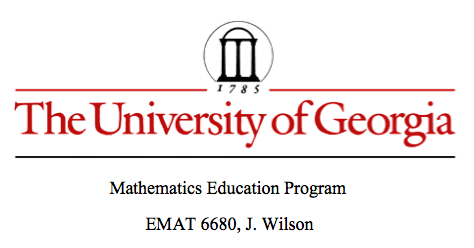

Ceva's Achievement
by Patty Wagner
Giovanni Ceva (pronounced chay'va) was an Italian mathematician who lived from 1647 until 1734. The work for which he is most known was published in 1678. Because of his novel idea and proof, students all over the world use a form of his name to describe a common geometric set of lines. We will explore the nature of these lines, consider his theorem, and attempt to conceptually understand its proof.
A popular high school exercise is to consider the centers of a triangle. The word centers is perhaps ill-chosen, since many of these so-called centers will actually fall outside the area of the triangle depending on the the angles involved. To keep things simple we will consider just one type of triangle in our exploration.
After drawing an acute triangle, imagine drawing a straight line from each vertex to its opposite side. At what point it crosses the line is unimportant to us initially. Here is an example you can play with. Just grab one of the black dots and drag it along the line that marks the triangle. You can even take it outside the triangle. Play with all the dots and see if anything interesting occurs.
The blue lines that you have been experimenting with are often referred to as cevians (pronounced che'vians) in honor of Giovanni Ceva. He developed an interesting theorem after examining these lines. He noticed, as you probably did, that if he moved the lines just so, he could make them all intersect in one point. There are multiple ways for this to be done - did you find at least two types?

In his well-known 1678 publication, Ceva theorized a unique relationship between the sides of the triangle and its cevians (Ceva did not refer to the lines as cevians in his work and he undoubtedly had no idea he would be memorialized in this way). His theorem, which is now called "Ceva's Theorem" is essentially the following:
Given a triangle ABC and points d, e, and f on sides AC, BC, and AB respectively, the cevians are concurrent if and only if:
To fully understand and appreciate Ceva's Theorem, we need to look closely at what it means and why it's true. Consider the relationship between the triangles created by the cevians and the sides.
We know this is true because the height of triangle BGE and CGE are the same, so if we examine their areas we have:
Similarly we can see that
From here we can see that
Following the same reasoning with the other sides of the triangle we can easily see that
and that
And now we can easily see that if we multiply these equations together we get:
In order to fully understand Ceva's Theorem, we have just worked through what is actually the first half of the proof of the theorem. Since we have gone this far, we may as well finish the proof. All that is left is to prove the converse; that is, if we start with points D, E, and F that satisfy the equation above, they will intersect at some point, G, and thus they are concurrent.
Since we can't begin this part of the proof assuming concurrency, we will consider just two cevians, BD and AE. We know that these two lines will intersect at some point which we will call G, since they are not parallel.
Now let's consider the remaining side, AB. We know we have a point on AB, namely point F. At issue is whether the cevian from vertex C will pass through point F.
We do know from the first half of our proof that there is a point, we'll call it x, such that
Comparing with our equation above, we see that
Does it follow then that X = F?
Let's try adding a to each side. We get this equation:
Let's replace our numbers with something more friendly like this:
Now we can use the fact that XB + AX = AB and AF + FB = AB (look at the line AB in the diagram above in order to conceptualize this.)
Our equation looks like this:
and we can see that X must equal F.
Why is Ceva's Theorem considered such an achievement? There are many instances where cevians are concurrent, and each of them plays a different role in Geometry. Using Ceva's Theorem allows mathematicians to easily prove the concurrency of medians, angle bisectors, and altitudes in a triangle, among others. A good conceptual understanding of Ceva's Theorem will enable you to easily bypass rigorous proof for each of these phenomena and get to more interesting considerations!
Return to Patty Wagner's home page